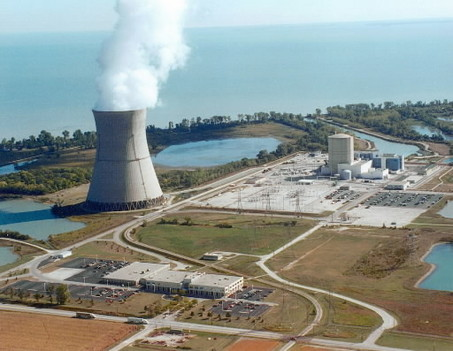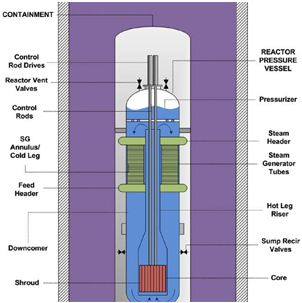
Blog
-
Geiger Readings for May 6, 2014
Ambient office = 125 nanosieverts per hourAmbient outside = 117 nanosieverts per hourSoil exposed to rain water = 126 nanosieverts per hourOrange bell pepper from Top Foods = 109 nanosieverts per hourTap water = 84 nanosieverts per hourFiltered water = 66 nanosieverts per hour -
Nuclear Reactors 123 – Many U.S. Nuclear Power Stations are not in Compliance with NRC Fire Safety Rules
In 1975 at the Brown’s Ferry nuclear power plant in Alabama, they were having problems with electrical wiring below the control room. There were air leaks in the cable spreading room and engineers were working to repair the leaks with spongy foam rubber. One of the men was using a candle to detect the air leaks. When he held the candle too close to a piece of the foam rubber, it burst into flame. The fire spread and destroyed a lot of the wiring including the controls for the emergency cooling system. There was almost a meltdown in the core of the reactor.
In 1980, the Nuclear Regulatory Commission drafted and adopted new rules for comprehensive fire protection to prevent any more fires like the one at Brown’s Ferry. Over the next twenty years, the NRC discovered that about half of the one hundred and four nuclear power plants in the U.S. did not comply with the new fire safety standards. Some of the plants that were not in compliance would required very expensive changes that would have afforded little more protection. The U.S. nuclear industry resisted the demand for compliance.
In response to the industry resistance to the new standards, the NRC came up with new rules in 2004 that gave the owners of nuclear power plants an option. The plant operators could bring their installations into compliance with the 1980 NRC fire safety rules or they could opt to meet the National Fire Protection Association’s (NFPA) standards for nuclear power plants that were based on performance. In contrast to the 1980 rules that state what plants are required to do and how those tasks should be accomplished, the alternative NFPA standards points out what the end result of changes should be but they do not explain exactly what the nuclear plants have to do to meet the NFPA standards. It is left to the individual nuclear power plants to assess the risk of fire throughout the plant and then to make procedural and/or physical changes to mitigate the risks. The two sets of standards are obviously different in their details but the end result of both standards is to insure that the nuclear power plant would be safer from the risk of fires.
In 2005, about four dozen nuclear power plants notified the NRC that they were planning on moving to the NFPA standards. Implicit in these notifications is the admission that those nuclear power plants were not in compliance with the 1980 NRC standards despite the fact that twenty five years had passed since the new NRC standards were adopted. Analyses of nuclear plant risks show that about half of the risk of triggering a nuclear core melt down can results from fires even taking the new fire safety standards into account.
FirstEnergy has petitioned the NRC for more time to complete the exhaustive reviews and analyses that the NRPA standards require before any work can be done at their Davis-Besse Nuclear Power Station in Ohio. FirstEnergy says that they can finish the review process by 2015. Then they want to wait until the NRC issues a ruling on the NRPA plan before starting any work. If the NRC accepts their proposal, that means that there will be no work on mitigating fire risks before 2017 at the earliest. They want to continue to violate NRC rules for another three years at least. This is the sort of lax regulation that makes me nervous. A quarter of the nuclear power plants in the U.S. are at greater risk for fires and meltdowns than they would be if the NRC did not allowed them to drag their feet for decades before complying with improved fire safety standards. If a fire at one of these plants results in a serious nuclear accident, just remember that it could have been prevented.
Davis-Besse Nuclear Power Station:
-
Geiger Readings for May 5, 2014
Ambient outside = 126 nanosieverts per hourSoil exposed to rain water = 135 nanosieverts per hourOrange bell pepper from Top Foods = 95 nanosieverts per hourTap water = 84 nanosieverts per hourFiltered water = 66 nanosieverts per hour -
Radiation News Roundup May 4, 2014
Japanese drones come back with footage of Fukushima destructions three years after the earthquake. voiceofrussia.com
A prestigious group of international scientists is interested in the risk to the U.S. West Coast from the Fukushima radioactive plume. enenews.com
Nuclear inspectors are going to visit Iranian nuclear sites. foxnews.com
Japan’s Toshiba Corporation says it will invest 337 million US dollars in a nuclear power station to be built at Moorside, in Cumbria, northwest England. nucnet.org
-
Geiger Readings for May 4, 2014
Ambient office = 114 nanosieverts per hourAmbient outside = 113 nanosieverts per hourSoil exposed to rain water = 121 nanosieverts per hourOrange bell pepper from Top Foods = 105 nanosieverts per hourTap water = 92 nanosieverts per hourFiltered water = 77 nanosieverts per hour -
Geiger Readings for May 3, 2014
Ambient office = 86 nanosieverts per hourAmbient outside = 67 nanosieverts per hourSoil exposed to rain water = 74 nanosieverts per hourOrange bell pepper from Top Foods = 98 nanosieverts per hourTap water = 112 nanosieverts per hourFiltered water = 97 nanosieverts per hourHalibut – Caught in Canada = 86 nanosieverts per hour -
Nuclear Reactors 122 – Prospects Dimming for Small Modular Reactors
I have blogged before about small modular reactors (SMR). There are different definitions of SMRs but for the purpose of this post, they generate under five hundred megawatts. The intent is to mass produce them in factories and then transport them to sites where they will be used. SMRs are still being designed, with investors and customers being sought. The U.S. Department of Energy is sinking about five hundred million dollars into research in cooperation with commercial firms.
Babcock & Wilcox had an arrangement with DoE where each would put one hundred fifty million each year to support the development of their mPower SMR. A year after the deal was signed, B&W has announced that it is scaling back its investment to fifteen million a year because they have been unable to find investors and customers. Investors are just not eager to put billions of dollars into SMR development which could take a decade or more. B&W is one of two companies working on SMRs with the DoE.
An SMR company called NuScale has had a rough time over the past few years with the SEC investigating some of the principle investors and shutting down the plant. New investors have been found and NuScale is back in business. In 2013, NuScale was selected as the second SMR company to receive DoE funds to support SMR development.
Westinghouse was also working on a SMR development project but they recently scaled back funding for the project when they lost out to B&W and NuScale for support from the DoE. Westinghouse has joined other companies in a consortium to license and build the Westinghouse SMR design for startup in 2022. Delays in the licensing will push the project back several years.
While prospects for SMRs are dimming in the United States, China is moving forward with small thorium nuclear reactor development. While the press in China is generally enthusiastic about this development, there have been articles that point out problems such as intense pressure to succeed quickly, intractable design issues, technical problems with handling molten salts in the reactor, extremely high operating temperatures, and engineering difficulties India is also very interested in developing thorium reactors. The thorium reactors is favored by Australian proponents of SMRs.
In March of this year, the Australian Department of Industry submitted materials for inclusion in an official government White Paper on energy. The DoI is advocating the development of small modular reactors to provide electricity to remote area of Australia. The Grattan Institute has proposed a line of SMRs along Australia’s East Coast, connected to the national power grid.
There is current interest in placing SMRs on barges or vessels that can be towed to where the energy is needed. This could provide power for remote communities as well as oil exploration and drilling. The Russians are building a floating nuclear power station which is slated to be anchored in a harbor. MIT recently put forward a design for a nuclear power station on floating platform located six miles out to sea.
The cost of construction per kilowatt for SMRs are expected to be about the same as for the construction of a full sized conventional nuclear reactor. The electricity generated will cost about the same as convention nuclear power generation. The primary attraction is the convenience and uniformity of factory production and the ability to transport the finished reactors to remote locations. All in all, the global future of the development and operation of small modular reactors is highly uncertain.
Diagram of the NuScale Small Modular Reactor;
-
Radiation News Roundup May 2, 2014
Japanese officials admit it may be impossible to stop leaking at Fukushima reactors. enenews.com
Locals feel that the damaged Fukushima plant could explode at any minute. enenews.com
Nuclear Regulatory Commission scrutinize safety issues at Browns Ferry and Brunswick nuclear plants. nuclearstreet.com





